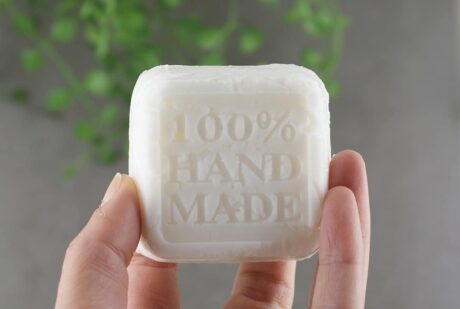
I’m sure this is a familiar sight for any cold process soap maker – the container (or boxes in my case) of soap shavings and off cuts which are left over when you cut and tidy your soaps.
All of our bathrooms at work have my soap off cuts for hand washing, and you’ll more likely than not, find lumps of squished together soap scraps in most of my family’s homes – we haven’t bought soap in a loooong time! But after you’ve been making soap for any length of time, you’ll come to realise it is virtually impossible for you to use all the scraps up! Every time I make a new batch of soap the pile grows. I haven’t weighed all my scraps, but at a guess I’d say I have roughly 5kg of off cuts at the moment!
I can’t stand the thought of wasting, so that’s where the re-batching method comes in. Sometimes this is called hand milled soap. Re-batching is the process of taking pre-made cold process soap and “melting” it down to create a new bar of soap. Keep in mind that re-batched soap tends to look pretty rustic so don’t plan on doing any fancy designs or swirls as it just won’t happen!
How to Rebatch Cold Process Soap
I picked out about 600 grams of light coloured scraps and grated them. You could do more or less depending on how many scraps you have, or how long you want to grate soap for! I’m lucky enough that I have an old food processor that I use solely for my soaping projects so I didn’t have to go through the nightmare of hand grating all the little scraps.
Once you’ve grated all your soap, put into your slow cooker, or double boiler. I’m using my slow cooker this time because I have lots of things to do today and don’t want to stand around monitoring the soap cooking. The beauty of the slow cooker is you can walk away and not have to worry about a pot burning dry. The trade-off is that it’s a slower method than using a double boiler. If you want to use a double boiler that’s totally fine. The method is the same, you just need to keep an eye on your soap and stir more often.
Once you have your grated soap in your cooker, add water (or milk). The amount of liquid depends on how old the soap scraps are. If you’re rebatching relatively fresh soap (less than two weeks old) you may only need a couple of tablespoons of water. However, many of my soaps are at least two years old, so I’m using half a cup of water. Don’t worry too much about over watering, it just means your soap might take a little longer to un-mould, but the quality will be the same.
Give the soap and water a quick stir, pop the lid on the crock pot and walk away. I came back about 30 minutes later and gave the mix a stir. After about 45 minutes, I added some extra soap that I had cut up into chunks. This isn’t necessary, but I wanted to add some interest to the soap so it wasn’t just a plain brown bar. After stirring the chunks through, I left the soap to melt again. All up I had the soap cooking for around one and a half hours.
You can see the consistency of the soap is very thick. The original soap that was grated has melted down, and the chunks that I added half way through are left pretty much in tact.
If you want to add fragrance, add it in right before you’re ready to mould. Stir in well. I used 30ml of Ambre Lumiere fragrance in this batch as there wasn’t much smell left in the soap scraps.
Spoon the soap into your mould. Make sure you tamp the mould down hard to get rid of air pockets. Depending on how much water you used, you will be able to un-mould the soap after about three hours. There’s no need to wait to use the soap, as all the scraps are old and fully cured a long time ago!








